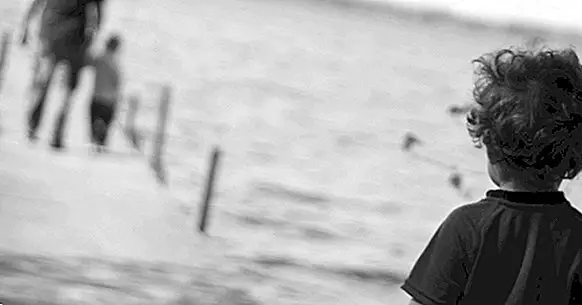Are there inborn fears?
We are all afraid of something. Fear is one of the most basic and powerful primary emotions that exist, as well as one of the most adaptive. And is that fear allows us to avoid stimuli that can generate some kind of damage or injury, activating our systems to give a quick response of flight or attack.
Most of our fears are learned from experience but ... are they all? The truth is that no. So that, Are there innate fears? In this article we are going to talk about it.
- Related article: "What is the use of fear?"
Acquired fear and innate fear: basic definition
There is a large number of classifications of the different existing fears, one of which divides them into two large groups: innate and acquired.
The acquired fears are those that have been learned throughout life, due to their appearance to the experience of situations that have generated a stimulus that becomes aversive or frightening.
Regarding the type of fear that concerns us in this article, innate fear, would be defined as the sensation of fear that is not born from experience but comes from genetic inheritance of our ancestors, this fear being something unconscious and common in the vast majority of human beings.
In addition to this difference, another one has been observed that may have useful implications at the treatment level: the innate fears and the conditioned fears are partly processed by different neuronal mechanisms. These differences can even be observed between different types of element to fear (for example, predators).
An evolutionary mechanism
The reason for the appearance of innate fears is the simple fact that they are linked to the survival of the species, being also the product of natural selection: those who at a specific moment were predisposed to be afraid of certain stimuli and avoided them survived more easily and were able to transmit their genes.
Likewise, innate fears are often identified with evolutionary fears in another sense: those that arise throughout the evolutionary development of each subject, appearing and sometimes disappearing as we mature. In this sense, it is true that Much of the fears we have in childhood are innate (although they are affected by learning), but nevertheless we must bear in mind that the majority of fears that we have throughout life are largely caused by learning or socialization.
For example, the fear of death is something that appears in the human being but that in the end is the product of cultural learning. The same can be said of the fear of failure, or the fear of fantastic beings. With this we pretend to say that although they are often similar, Evolutionary fears are not always innate .
An innate fear, but not unchangeable
The fact that there are innate fears does not mean that they can not vary. Learning is a powerful tool that can cause the intensity of felt fear to be reduced ostensibly, and other alterations can also generate a loss of fear.
This is what happens with some mice, which lose the innate fear of cats when they are infected by the parasite toxoplasma gondii and whose loss of fear remains even when the infection has been eliminated. In addition to that, alterations and brain injuries They can alter the ability to feel fear, especially if they affect the limbic system.
Several examples
The existence of innate fears is visible in different cases that are repeated throughout the world throughout our development and without having to suffer any kind of damage. In this sense we can see many examples, of which we select several below. Most of them appear throughout the development , although some of those that appear in this period are derived either from the direct experience of aversive experiences or from vicarious or cultural learning.
1. loud noises
From the moment we are born, we can see how most babies burst into tears when they hear a loud noise. This fear is largely due to surprise or the detection of a possible danger, and even in adulthood causes fright. It usually appears at birth or in a period between the first two years of life . It is visible in the existence of innate reflections of protection against these sounds, as well as in the fact that we are immediately oriented towards its source.
2. Darkness
The fear of the dark is one of the best-known innate fears, as well as one of the most easily analyzed their evolutionary sense. The human being as a species is essentially diurnal, not having great adaptations that allow us to see possible dangers lurking. Interestingly, although innate this fear is detected between two and six years of age.
3. Heights and falls
The fear of falling is another of the best-known innate fears, appearing between six months and around the first year of life. This is because we started to detect the depth. While there may be experiences of falls involved in this fear, the truth is that the body itself has reflections that try to avoid them , the most visible example being the so-called Moro reflex.
- Maybe you're interested: "The 12 primitive reflexes of babies"
4. Strangers
Another fear that we might consider innate is the fear of strangers, which usually appears around the third quarter of life. This fear is not elicited by the presence of an aversive experience that generates its appearance, although education can influence it. Many babies, for example, they start to cry or stop smiling to see someone unknown .
5. Separation and loneliness
Nobody teaches us to be afraid of being alone, nor does it have a detrimental effect on the organism that can make us fear it. However, many children are afraid to be separated from their parents. A fear that usually appears between two and six years of age.
6. Fear of storms
This fear is usually quite frequent in childhood and even many adults are still afraid. In this case we are probably facing a fear derived from the set of light and sound of lightning and thunder. It is also something inherited, given that throughout our evolution we have needed to take refuge from storms given its danger.
7. Fear of certain animals
The fear of beings like spiders and snakes has an evolutionary meaning that makes many people avoid them. It is also observed that in many children there is a certain fear of small animals during childhood. Also, it has been observed that exposed to the image of a possible predator, many animal species react with fear and tend to avoid it even without having had previous experiences with this animal.
However, in the human being there is debate about whether this fear can not really be a conditioned fear: it has been observed on the other hand that, if we place a baby near animals considered dangerous such as snakes, probably awakens more curiosity than fear. In this sense, fear could be due in some degree to cultural learning.
8. Scents
Although not so much in the human being as in other animal species, some odors can also generate a high level of fear. This is what happens, for example, in the case of mice when they smell the urine of a cat or with other beings when they perceive the odors of their natural predators.
Bibliographic references:
- Silva, B.A., Gross, C.T. & Gräff, J. (2016). The neural circuits of innate fear: detection, integration, action and memorization. Learning & Memory, 23 (10): 544-555.



















